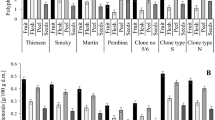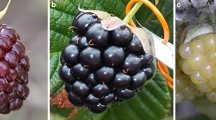Abstract
Thirteen fruits, eight legumes and three tubers consumed in the Andean regions of Ecuador were studied to determine their bioactive compounds, organic acids, sugars content, total antioxidant capacity, as well as to determine which among them showed the greatest contribution in terms of antioxidant activity and which compounds contributed to it. Among fruits, taxo fruits (Passiflora mollissima (Kunth) L.H. Bailey) presented the highest values of total phenolic, carotene content, and total antioxidant capacity. The ají ratón (Capsicum chinense Jacq) showed the highest content of vitamin C. Taxo showed the highest content of β carotene, whilst lycopene was identified only in guayaba fruits (Psidium guajava L.) and ají ratón was the principal source of lutein. In legumes, chocho perla (Lupinus mutabilis Sweet) showed the highest values for both total phenolic and flavonoid content, whilst frejol negro (Phaseolus vulgaris L.) and frejol canario (Vigna unguiculata (L.) Walp) showed the highest values for FRAP and DPPH assay, respectively. Between tubers, the jícama (Smallanthus sonchifolius (Poepp.) H. Rob.) had the majors values in terms of total phenolic, flavonoid content, and total antioxidant capacity. In terms of total antioxidant capacity, taxo fruits have the highest contribution in terms of total antioxidant capacity, whilst the dendogram shown the occurrence of five distinct groups in which taxo was located in the first largest group. Our data contributing towards gaining better knowledge about the Andean Ecuadorian diet and the composition of Andean food in order to estimate dietary intakes of health-promoting components.

Similar content being viewed by others
Abbreviations
- TPC:
-
Total phenolic content
- TFC:
-
Total flavonoid content
- ACY:
-
Total anthocyanin content
- FW:
-
Fresh weight
- TAC:
-
Total antioxidant capacity
- FRAP:
-
Ferric reducing antioxidant power
- DPPH:
-
2,2-diphenyl-1-picrylhydrazyl
- TCC:
-
Total carotenoid content
References
Tene V, Malagón O, Finzi PV, Vidari G, Armijos C, Zaragoza T (2007) An ethnobotanical survey of medicinal plants used in Loja and Zamora-Chinchipe, Ecuador. J Ethnopharmacol 111:63–81. https://doi.org/10.1016/j.jep.2006.10.032
Carrillo-Perdomo E, Aller A, Cruz-Quintana SM, Giampieri F, Alvarez-Suarez JM (2015) Andean berries from Ecuador: a review on botany, agronomy, chemistry and health potential. J Berry Res 5:49–69
Vasco C, Ruales J, Kamal-Eldin A (2008) Total phenolic compounds and antioxidant capacities of major fruits from Ecuador. Food Chem 111:816–823. https://doi.org/10.1016/j.foodchem.2008.04.054
Vasco C, Riihinen K, Ruales J, Kamal-Eldin A (2009) Phenolic compounds in rosaceae fruits from Ecuador. J Agric Food Chem 57:1204–1212. https://doi.org/10.1021/jf802656r
Vasco C, Riihinen K, Ruales J, Kamal-Eldin A (2009) Chemical composition and phenolic compound profile of mortiño (Vaccinium floribundum Kunth). J Agric Food Chem 57:8274–8281. https://doi.org/10.1021/jf9013586
Alarcón-Barrera KS, Armijos-Montesinos DS, García-Tenesaca M, Iturralde G, Jaramilo-Vivanco T, Granda-Albuja MG, Giampieri F, Alvarez-Suarez JM (2018) Wild Andean blackberry (Rubus glaucus Benth) and Andean blueberry (Vaccinium floribundum Kunth) from the highlands of Ecuador: nutritional composition and protective effect on human dermal fibroblasts against cytotoxic oxidative damage. J Berry Res 8:223–236. https://doi.org/10.3233/JBR-180316
Alvarez-Suarez JM, Carrillo-Perdomo E, Aller A, Giampieri F, Gasparrini M, González-Pérez L, Beltrán-Ayala P, Battino M (2017) Anti-inflammatory effect of Capuli cherry against LPS-induced cytotoxic damage in RAW 264.7 macrophages. Food Chem Toxicol 102:46–52. https://doi.org/10.1016/j.fct.2017.01.024
Singleton VL, Orthofer R, Lamuela-Raventós RM (1998) Analysis of total phenols and other oxidation substrates and antioxidants by means of folin-ciocalteu reagent. Methods Enzymol 299:152–178. https://doi.org/10.1016/S0076-6879(99)99017-1
Dewanto V, Wu X, Adom KK, Liu RH (2002) Thermal processing enhances the nutritional value of tomatoes by increasing total antioxidant activity. J Agric Food Chem 50:3010–3014
Giusti M, Wrolstad RE (2005) Characterization and measurement of anthocyanins by UV-visible spectroscopy. In: Handbook of food analytical chemistry. John Wiley & Sons, Ltd, pp 19–31
Wang L, Fu H, Wang W, Wang Y, Zheng F, Ni H, Chen F (2018) Analysis of reducing sugars, organic acids and minerals in 15 cultivars of jujube (Ziziphus jujuba mill.) fruits in China. J Food Compos Anal 73:10–16. https://doi.org/10.1016/j.jfca.2018.07.008
Doyon G, Gaudreau G, St-Gelais D, Beaulieu Y, Randall CJ (2013) Simultaneous HPLC determination of organic acids, sugars and alcohols. Can Inst Food Sci Technol J 24:87–94. https://doi.org/10.1016/s0315-5463(91)70025-4
Benzie IFF, Strain JJ (1996) The ferric reducing ability of plasma (FRAP) as a measure of “antioxidant power”: the FRAP assay. Anal Biochem 239:70–76. https://doi.org/10.1006/abio.1996.0292
Prymont-Przyminska A, Zwolinska A, Sarniak A, Wlodarczyk A, Krol M, Nowak M, de Graft-Johnson J, Padula G, Bialasiewicz P, Markowski J, Rutkowski KP, Nowak D (2014) Consumption of strawberries on a daily basis increases the non-urate 2,2-diphenyl-1-picryl-hydrazyl (DPPH) radical scavenging activity of fasting plasma in healthy subjects. J Clin Biochem Nutr 55:48–55. https://doi.org/10.3164/jcbn.13-93
Gancel A-L, Alter P, Dhuique-Mayer C, Ruales J, Vaillant F (2008) Identifying carotenoids and phenolic compounds in Naranjilla ( Solanum quitoense lam. var. Puyo hybrid), an Andean fruit. J Agric Food Chem 56:11890–11899. https://doi.org/10.1021/jf801515p
Espin S, Gonzalez-Manzano S, Taco V, Poveda C, Ayuda-Durán B, Gonzalez-Paramas AM, Santos-Buelga C (2016) Phenolic composition and antioxidant capacity of yellow and purple-red Ecuadorian cultivars of tree tomato (Solanum betaceum Cav.). Food Chem 194:1073–1080. https://doi.org/10.1016/J.FOODCHEM.2015.07.131
Campos D, Chirinos R, Gálvez Ranilla L, Pedreschi R (2018) Bioactive potential of Andean fruits, seeds, and tubers. In: Advances in food and nutrition research. Academic Press, pp 287–343
Kantar MB, Anderson JE, Lucht SA, et al (2016) Vitamin variation in Capsicum spp. provides opportunities to improve nutritional value of human diets. https://doi.org/10.1371/journal.pone.0161464
Bazalar Pereda MS, Nazareno MA, Viturro CI (2018) Nutritional and antioxidant properties of Physalis peruviana L. fruits from the Argentinean northern Andean region. Plant Foods Hum Nutr 74:68–75
Ramful D, Tarnus E, Aruoma OI, Bourdon E, Bahorun T (2011) Polyphenol composition, vitamin C content and antioxidant capacity of Mauritian citrus fruit pulps. Food Res Int 44:2088–2099. https://doi.org/10.1016/j.foodres.2011.03.056
Li Y, Schellhorn HE (2018) New developments and novel therapeutic perspectives for vitamin C. J Nutr 137:2171–2184. https://doi.org/10.1093/jn/137.10.2171
Compounds I of M (US) P on DA and R (2000) Dietary reference intakes for vitamin C, vitamin E, selenium, and carotenoids. National Academies Press (US)
Chávez-Mendoza C, Sánchez E (2017) Bioactive compounds from Mexican varieties of the common bean (Phaseolus vulgaris): implications for health. Molecules 22:1360. https://doi.org/10.3390/molecules22081360
García-Ruiz A, Girones-Vilaplana A, León P, Moreno D, Stinco C, Meléndez-Martínez A, Ruales J (2017) Banana passion fruit (Passiflora mollissima (Kunth) L.H. bailey): microencapsulation, phytochemical composition and antioxidant capacity. Molecules 22:85. https://doi.org/10.3390/molecules22010085
García-Cruz L, Valle-Guadarrama S, Salinas-Moreno Y, Joaquín-Cruz E (2013) Physical, chemical, and antioxidant activity characterization of pitaya (Stenocereus pruinosus) fruits. Plant Foods Hum Nutr 68:403–410. https://doi.org/10.1007/s11130-013-0391-8
Khayyat M, Barati Z, Aminifard MH, Samadzadeh A (2018) Changes in fruit maturity indices and growth pattern along the harvest season in seedless barberry under different altitude conditions. J Berry Res 8:25–40. https://doi.org/10.3233/JBR-170166
Walker RP, Famiani F (2018) Organic acids in fruits. In: Horticultural reviews. John Wiley & Sons, Inc., Hoboken, NJ, USA, pp 371–430
United States Department of Agriculture Agricultural Marketing Service Fruit and Vegetable Division Processed Products Branch United States Standards for Grades of Extracted Honey
Funding
This study was funded by the Universidad de Las Américas [grant number: VET.JMA.17.05], Quito, Ecuador. Access to plant genetic resources was granted by means of the “Framework agreement for access to plant genetic resources: MAE-DNB-CM-2017-0072-M-001” celebrated between the Environment Ministry, Ecuador and the Universidad de Las Américas, Ecuador.
Author information
Authors and Affiliations
Corresponding authors
Ethics declarations
Conflict of Interest
The authors declare no conflicts of interest.
Additional information
Publisher’s Note
Springer Nature remains neutral with regard to jurisdictional claims in published maps and institutional affiliations.
Electronic supplementary material
ESM 1
(DOC 214 kb)
Rights and permissions
About this article
Cite this article
Pérez-Balladares, D., Castañeda-Terán, M., Granda-Albuja, M.G. et al. Chemical Composition and Antioxidant Activity of the Main Fruits, Tubers and Legumes Traditionally Consumed in the Andean Regions of Ecuador as a Source of Health-Promoting Compounds. Plant Foods Hum Nutr 74, 350–357 (2019). https://doi.org/10.1007/s11130-019-00744-8
Published:
Issue Date:
DOI: https://doi.org/10.1007/s11130-019-00744-8




